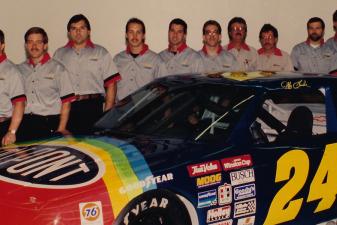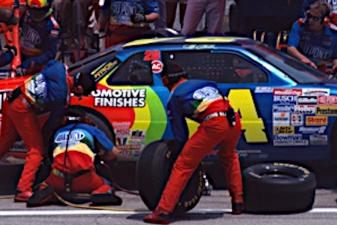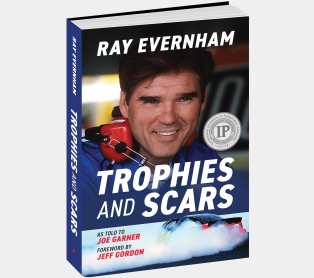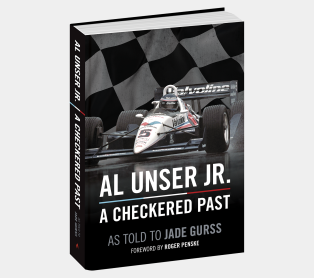The Secret Strategy Behind Jeff Gordon's First NASCAR Cup Win

The following is an excerpt from NASCAR crew chief Ray Evernham's autobiography, Trophies and Scars. You needn’t be a racing fan to appreciate Evernham’s inspiring journey of tireless persistence, radical determination, steadfast leadership, and fearless reinvention. For as he believes, a life lived to the fullest is packed with trophies—and scars. In this excerpt, Jeff Gordon and the Rainbow Warriors dazzle the crowd at the 1994 Coke 600 with some quick thinking.
Going into NASCAR’s longest race, I put a lot of focus on strategy and preparation.
One of the things I studied was the impact of two-tire pit stops. I was aware that cautions often happened toward the end of the race, and we needed to be prepared for any situation. I assigned my engineer Brian Whitesell the task of researching the last five years of Coke 600 races to determine the average time when cautions occurred.
Armed with Brian’s data, we came up with a plan, but it was only going to work under green-flag pit stops.
We figured a pit stop for four tires took an average of seventeen seconds. I knew our guys could change two tires in about nine seconds. I also figured that having two fresh tires rather than four would slow us down by two-tenths of a second.
So, if we were only two-tenths of a second slower, with a gain of eight seconds due to our faster pit, there would be no way they could catch us if there were twenty laps or less to go in the race.
But our lead wouldn’t last forever. My fear was the caution flag. With four tires, you’d be able to maintain speed longer, but I was prepared to roll the dice.
Although we started from the pole, the lead changed hands twenty-five times in that race. It was crazy.
We fought back and forth the whole race. We had a good car, but Rusty Wallace’s was better. Both Rusty and Geoff Bodine were driving Fords. We felt like we were the best Chevy out there, even better than Earnhardt.
We were running third, with Rusty ahead of us by a decent lead of three or four seconds. And then, cars started to pit. I kept waiting to see what our competitors would do because I wanted to pit once we were inside that twenty-lap window.
Rusty pitted with around twenty-two or twenty-three laps to go. He took four tires. Before pitting, Rusty had a three- or four-second lead on us. His pit stop was seventeen seconds.
To speed up our pit stop, I knew we could do just the two new tires with adding only enough fuel to get us to the end of the race.
I thought, “Okay, Rusty’s pit stop was seventeen seconds with a four-second lead on us. That gives us thirteen seconds. We can do this pit stop in about seven seconds and come out with a six-second lead. If we’re only losing two- to three-tenths of a second per lap to Rusty, with only eighteen laps to go there’s no way he can catch us before the race ends unless there’s a caution.”
I keyed my radio, telling Jeff and the crew, “All right, guys. Two! Two! Two!”
Mr. Hendrick, seated beside me on the pit box, glanced at me with a concerned look. “You sure you wanna do that?”
I had a plan, and I was confident. “Yeah, we’re goin’ with two.” He nodded at me and said, “Okay.”
Jeff came down Pit Road and the guys executed the pit stop perfectly. We put a splash of gas in, two tires, and he came right back out.
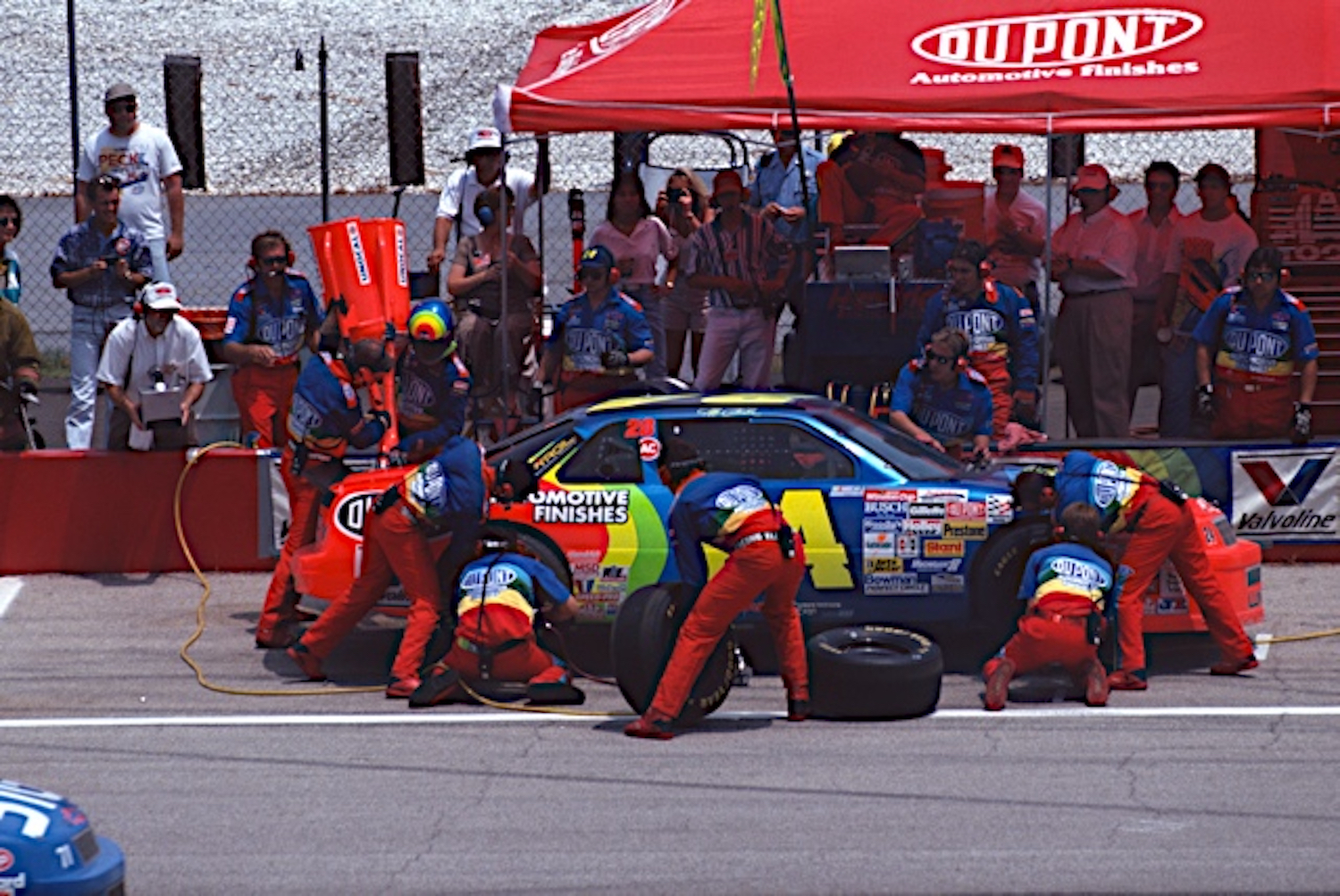
Now, we had about a five-second lead on Rusty.
Still, I expected him to catch us little by little as he had four new tires. Looking at my stopwatch, I thought, “Shit, not only is he not catching us, Jeff’s pulling away.”
With fewer than eighteen laps left, I couldn’t believe it, we were winning!
Then, inside ten laps to go, I heard Richard Petty, who was doing TV commentating, second-guess my pit decision. “Gordon takin’ just two tires might’ve been a mistake.”
If a caution had come out, he would have been right.
I didn’t blame The King for questioning my decision. Throughout my career, I was often questioned because we won several races taking just two tires. They didn’t understand the strategy behind it. They just couldn’t figure out how we did it.
Depending on the circumstance, we’d either put on new lefts or rights, but the real secret was in tire pressure. People back then seemed to overlook the importance of tire pressure. Having worked closely with Goodyear Engineering on radial tire development during my IROC days, I had a good understanding of just how important correct tire pressure was to the radial tire.
I also spent time at Penske Shock, where I learned how critical shock tuning is to the radial tire. A shock designed for a radial tire varies from one meant for a bias ply tire. Our cars always had better tire wear than our competitors because we paid attention to these details.
Besides only taking two tires in the 600, we also didn’t fill our gas tank all the way up. We only put enough in to finish the race, making our car lighter and faster.
As we’d hoped, there was no caution flag. The race stayed green, and Jeff collected his first NASCAR Cup points-race checkered flag. Our first win was a combination of Jeff’s driving talent and simple math.

That Charlotte victory is forever etched in my memory, not just because it was our first, but also because of Jeff’s tearful reaction. He was just a kid, and it was his dream to be a successful race car driver. It meant so much to win.
When we won our first Busch race at Atlanta, he cried then, too, and I began to understand him better. It was a sign of his passion—how much it meant to him.
When Jeff cried after winning his first Cup race at Charlotte, it hit me hard. I felt it.
I could see how far he’d come, how much he’d achieved. The sacrifices his stepdad, John, and his mom, Carol, had made to get him there, and the relentless pursuit of his dream—it was all there in that moment. It was a dream he’d nurtured for years, and to see it finally come to fruition was a beautiful thing.
To know I was part of it, and that our hard work had paid off, was an incredible feeling. I was proud and humbled to be part of something that meant so much to a friend.
The win made my head spin. I had so much going on, my mind was whirling like a tornado. I was trying to organize everything but at the same time, realizing all we had accomplished. It was a lot to take in.
I still joke today with Rick Hendrick about my call for two tires in the Coke 600 race. He was so nervous, he nearly wore the soles off his shoes from pacing around the pit area those last few laps. But I know this about Rick. If it had turned out to be the wrong call, he’s not a guy who would have said, “Told you so.”
Instead, he would have put his arm around me and told me we’d get it next time.
The next morning, as I drove past Charlotte Motor Speedway on my way to the shop, it hit me again. “Holy shit. We won the race last night.”
When I got to the shop, I was by myself for a bit and had time to reflect. We had won a prestigious NASCAR Cup race, and no one could take that away from us. It was a great accomplishment, and even if we never won again, we had that one.


